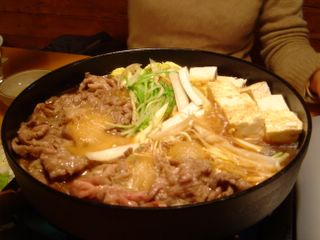But last Saturday was meant to be my day to eat sukiyaki. Driving back to our hotel from Karuizawa Prince Hotel ski resort, Robbee and Tomoko saw a restaurant with huge banners outside advertising all you can eat Sukiyaki for 168yen. Wait, something is wrong, the zero at the bottom of the banner was buried in snow. Ok, so it’s 1680yen for all you can eat. How can you beat that! I don’t know about you, but after a day of skiing, a big hearty beef meal is just what my stomach was longing for. Even Jason agreed to give it a try.
We went inside and promptly ordered the sukiyaki set. Two seconds later, the waitress brought out three platters: one laden with udon noodles, konnyaku noodles, and firm tofu; one piled high with napa cabbage, green onions, bean sprouts, mushrooms, and gobou (burdock); and another one with thinly sliced big pieces of marbled beef (being 1680yen, you can’t exactly be picky about the beef, so Matsuzaka-gyu it ain’t). She then placed on the table a big teapot-like container with the sukiyaki-tare (sauce), a bottle of lukewarm water to thin the tare if needed, and gave us each a little bowl with a raw egg inside. Last came the burner and a caste iron deep pan, with a little piece of lard in it. Wanting to find out what lard is called in Japanese, I asked the waitress what it was. Her reply? “Lah-doh.” Am glad we speak the same language! After waiting for a minute or so and then realizing that for this price, the waitress is probably not going to come and cook it for us, Tomoko took over.
First she turned on the burner and swirled the piece of lard around to coat the pan, then she poured some tare in. After the tare is heated, beef was put in, and then everything else followed. When the first piece of beef showed signs of being cooked, I was given the honor to try the first bite (to compensate for all those years of sukiyaki-deprivation).

I scrambled the raw egg in my little bowl per Tomoko’s instruction, and dipped the beef in. I know people in the US have this raw-egg phobia, thinking that’s a sure way of getting salmonella poisoning, but you just have to get used to the idea, and honestly, I have never heard of Japanese people getting food poisoning due to raw eggs. Maybe eggs here are just fresher.
Anyway, back to the sukiyaki. I loved it! The sweetness of the sukiyaki tare and the egg was the perfect combination. Some people might be turned off by the slipperiness of the raw egg but whoever thought of eating beef this way was a genius: it cools down the piping hot beef slightly so you can eat it right away; and the slippery eggs contrasts nicely with the beef grains. Can’t believe I wasted all these years without trying it.



 Stumble It!
Stumble It!
1 comment:
Maybe the sauce given to us was already thinned because we didn't put water in until later, when the sauce was reduced significantly. Did you buy a sukiyaki pot? Or just use a frying pan?
Post a Comment